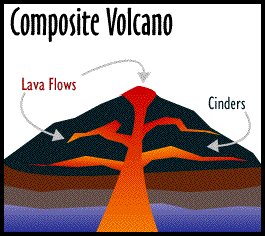

  |
 Types of Volcanoes Types of VolcanoesMost people have never seen a real volcano but have learned about them through movies or books. So when most people think of a volcano, they usually conjure up the Hollywood version: a huge, menacing conical mountain that explodes and spews out masses of lava which falls on rampaging dinosaurs, screaming cave people, or fleeing mobs of betogaed Romans--depending on their favorite volcano disaster movie. While those types of volcanoes do indeed exist, they represent only one "species" in a veritable zoo of volcano shapes and sizes. Some types of volcanoes are easily recognizable and some are not. The "Hollywood" types are easily recognized. Many are located in populated areas and have well-known names: Vesuvius, Krakatoa, Fujiyama, and Mount St. Helens. These volcanoes are typically tens of miles across and ten thousand or more feet in height. As illustrated in the figure above, they have moderately steep sides and sometimes have small craters in their summits. Volcanologists call these "strato-" or composite volcanoes because they consist of layers of solid lava flows mixed with layers of sand- or gravel-like volcanic rock called cinders or volcanic ash.
A third easily recognized volcano may be familiar to you from news reports from Hawaii: the "shield" volcano. This type of volcano can be hundreds of miles across and many tens of thousands of feet high. The individual islands of the state of Hawaii are simply large shield volcanoes. Mauna Loa, a shield volcano on the "big" island of Hawaii, is the largest single mountain in the world, rising over 30,000 feet above the ocean floor and reaching almost 100 miles across at its base. Shield volcanoes have low slopes and consist almost entirely of frozen lavas. They almost always have large craters at their summits.
[ Types of Volcanoes page 1 / page 2 ] [ Types of Lava ] [ Home ] [ Teacher Pages ] [ Modules & Activities ]
|
HTML code by Chris Kreger
Maintained by ETE Team
Last updated November 10, 2004
Some images © 2004 www.clipart.com
Privacy Statement and Copyright © 1997-2004 by Wheeling Jesuit University/NASA-supported Classroom of the Future. All rights reserved.
Center for Educational Technologies, Circuit Board/Apple graphic logo, and COTF Classroom of the Future logo are registered trademarks of Wheeling Jesuit University.